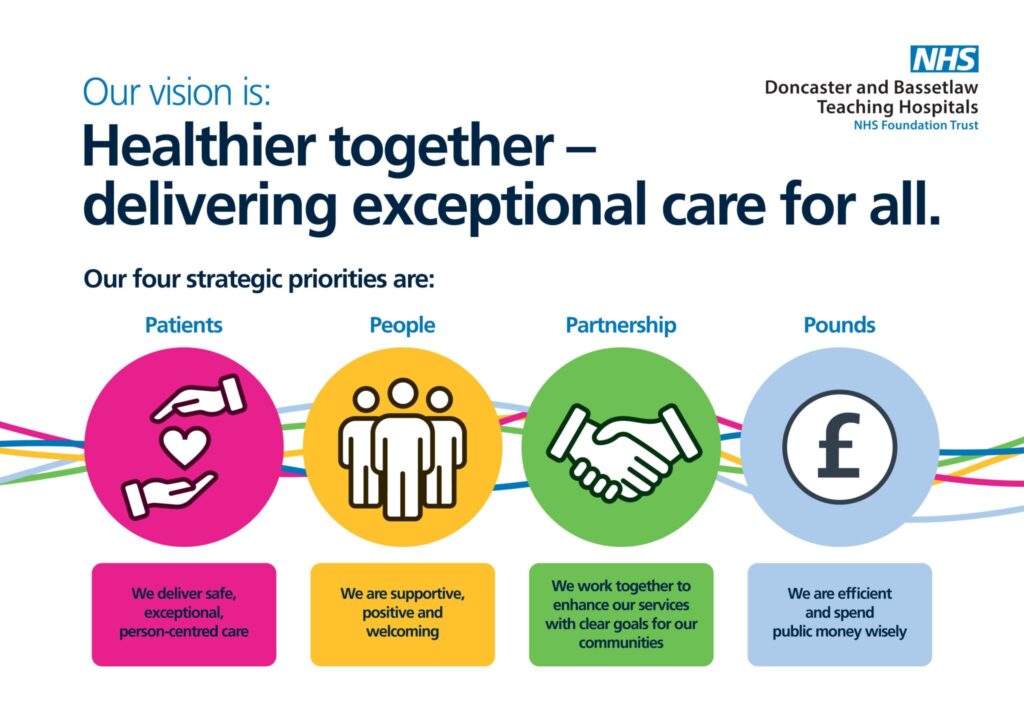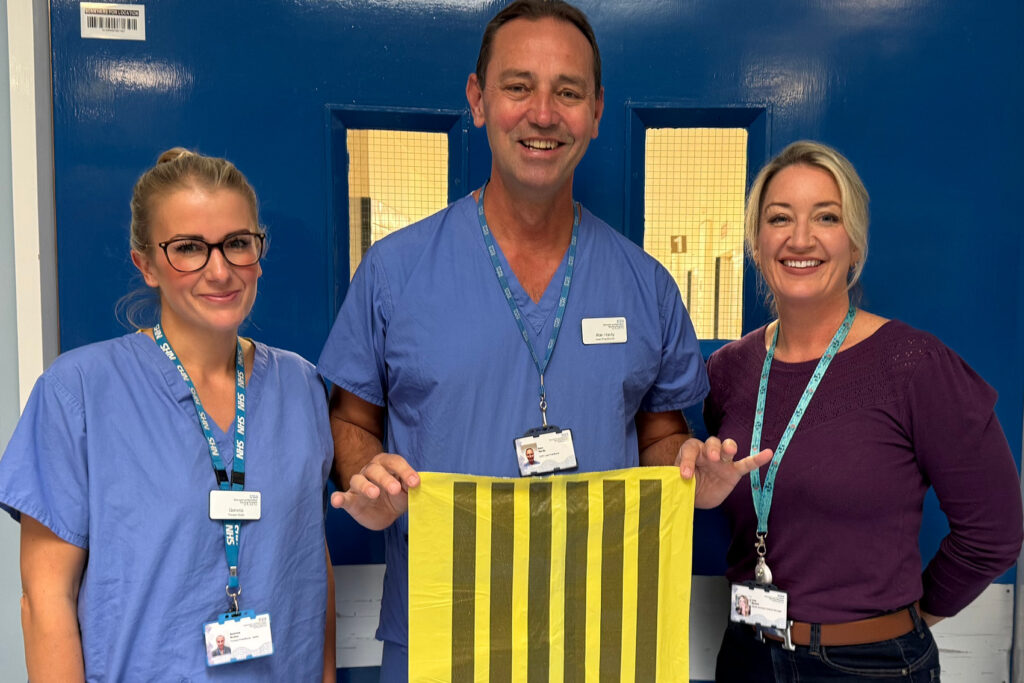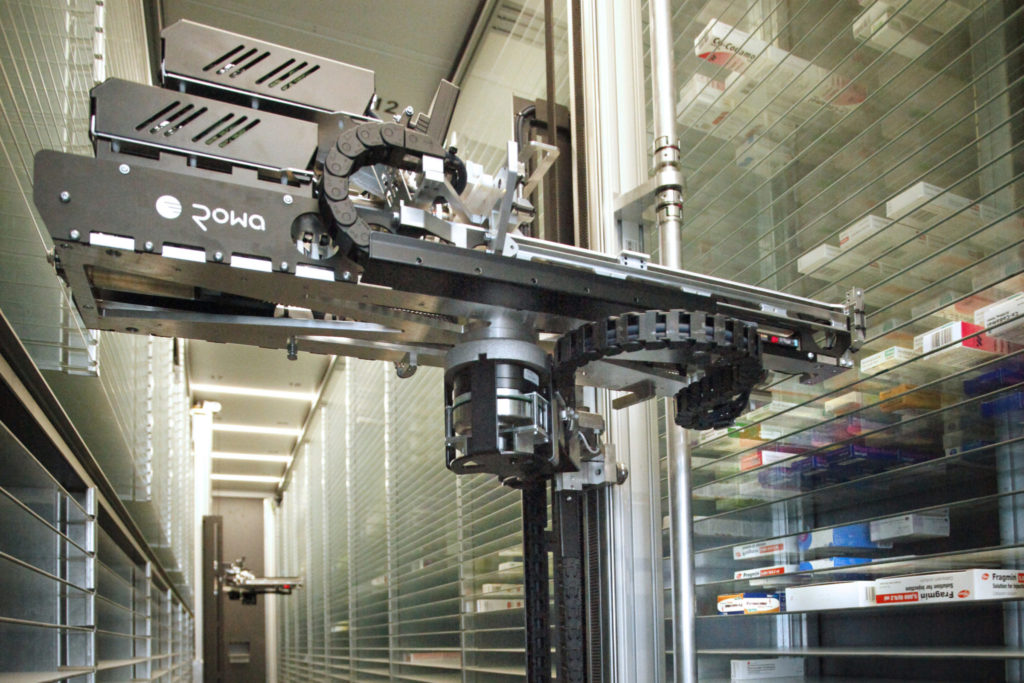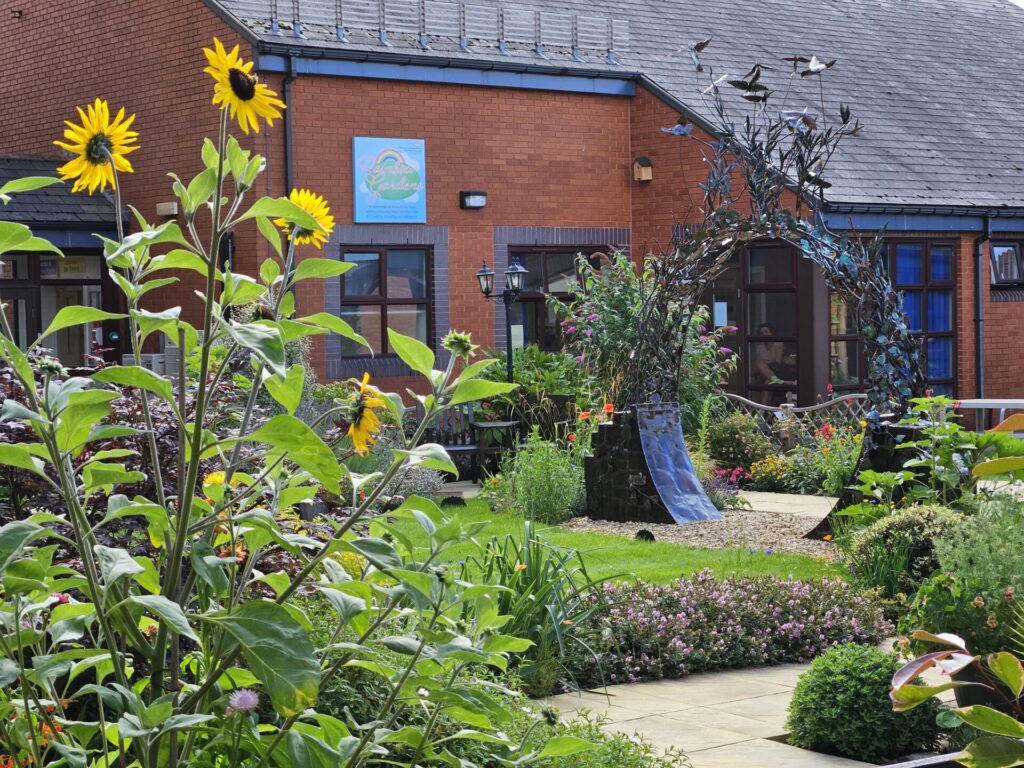There are a number of sections within this document. Using the links below, you can skip to specific sections.
- Foreword
- Introduction
- About us
- Why do we need a refreshed green plan?
- What are we seeking to achieve?
- Our Aims
- Our progress so far
- Developing this plan
- Working with our partners
- Areas of focus
- Governance and accountability
- Conclusion
If you need this page in another language, you can use an online translation service here. For more accessibility options and information, please visit the Trust’s Accessibility page here.

Foreword
As a Trust, we recognise the impact of climate change and the effect it has on the lives of people across the world. As one of the largest employers in our region, Doncaster and Bassetlaw Teaching Hospitals (DBTH) acknowledges its responsibility to act to reduce our environmental impact and protect the health and wellbeing of our communities.
This refreshed Green Plan sets out our strategic approach to delivering a more sustainable, efficient, and resilient health service over the next three years. It builds on the significant progress we have made so far, which includes the phasing out of desflurane, removing piped nitrous oxide infrastructure, investing in digital technology to support a more sustainable approach to care, and increasing the use of low-carbon technology and on-site renewables. Together, these actions provide a clear roadmap for further progress across all areas of our organisation.
The NHS is the first health system in the world to commit to reaching Net Zero, and we are proud to contribute to this nationally coordinated effort. Our plan is fully aligned with the ambitions of NHS England and the South Yorkshire Integrated Care Board, ensuring we continue to work in partnership to deliver greener, fairer healthcare at a system level. It also supports the vision set out in the Government’s Fit for the Future: 10-Year Health Plan for England, which emphasises more resilient, digitally enabled and sustainable services that protect health today and for future generations.
The measures in this plan will also help us to meet our legal duties under the Health and Care Act 2022 and to do so in a way that supports better outcomes, more efficient use of resources, and care that is fairer for all.
At DBTH, our vision is clear:
Healthier together — delivering exceptional care for all.

This includes care for our environment. Through strong leadership, robust governance, and the commitment of our people, we will ensure sustainability becomes an integral part of how we plan, deliver, and improve services. We thank all colleagues who have contributed to this work so far, and we look forward to building on this progress together in the years ahead.

Richard Parker OBE
Chief Executive at DBTH

Sam Wilde
Chief Finance Officer and Board-Level Net Zero Lead
The summary
If you’re short on time, you can listen to an audio summary of this strategy by clicking the media player below.
Introduction
As a large acute healthcare provider serving a diverse population across Doncaster, Bassetlaw and surrounding areas, we recognise that the health and wellbeing of our patients is directly influenced by the quality of the environment in which they live. The growing effects of climate change, such as rising temperatures, air pollution, and extreme weather, pose a serious and increasing risk to the NHS, particularly for the most vulnerable in our communities. At the same time, our services contribute to those environmental pressures. The NHS is responsible for approximately 4-5% of the UK’s total carbon emissions, with healthcare activity across clinical, estates, transport and supply chain systems all playing a role.
This plan reaffirms our commitment to being part of the solution. It sets out how we will align with the NHS’s ambition to achieve net zero for direct emissions by 2040, and for emissions we can influence by 2045. It also outlines how we will embed sustainability into our decision making, reduce the environmental impact of the care we provide, and improve the resilience of our estate and services. We have framed this plan around nine nationally mandated areas of focus, each supported by a clear set of SMART objectives, measurable performance indicators, and local actions tailored to the needs of our organisation and the people we serve.
This Green Plan also reinforces our commitment to national and regional collaboration. It has been developed in close alignment with the South Yorkshire ICB Green Plan and reflects our wider role as a system partner and anchor institution within our community. It integrates sustainability into our broader corporate strategy and supports the Trust’s vision of being Healthier together—delivering exceptional care for all.
Delivering sustainable healthcare requires coordinated and sustained effort from all parts of the organisation. Through strong leadership, clear governance, and the continued commitment of our people, we will ensure that DBTH plays a leading role in delivering a greener, fairer and more resilient health system for the future.
About us
We are an acute NHS Foundation Trust and teaching hospital, serving a diverse population of over 440,000 people across South Yorkshire, North Nottinghamshire, and surrounding areas.
We provide a wide range of high quality healthcare services throughout our three main hospitals – Doncaster Royal Infirmary, Bassetlaw Hospital, and Montagu Hospital – as well as additional services at smaller sites like Retford Hospital.
As a teaching hospital, we proudly work closely with local universities, contributing to the development of future healthcare professionals while advancing research and innovation. Our links with Integrated Care Partnerships and system partners, spanning South Yorkshire and Nottinghamshire, enable us to deliver seamless, person-centred care in collaboration with other health and social care organisations.
We are also home to some of the busiest emergency departments in the region, offering essential services ranging from emergency care to specialist tertiary care, such as vascular surgery.
Our vision, Healthier together – delivering exceptional care for all, underpins everything that we do, reflecting our ambition to improve lives and reduce inequalities through high quality, person centred sustainable healthcare.
Our vision reflects our ambition to provide exceptional, person-centred healthcare, while also working with our partners to improve the health and wellbeing of our communities. This vision is brought to life through our core values, expressed in the phrase “We Care”.
These values guide how we care for our patients, support our colleagues, and interact with our partners, shaping both our culture and our strategic decisions. These principles also underpin our commitment to sustainability, ensuring that our actions are socially responsible, environmentally conscious, and aligned with the long-term interests of the populations we serve.
Why do we need a refreshed green plan?
The NHS became the world’s first health system to commit to net zero carbon emissions in 2020. This ambition was formally set out in the Delivering a Net Zero National Health Service report, and further reinforced through the Health and Care Act 2022, which places a legal duty on NHS organisations to consider environmental sustainability and statutory emissions targets in all key decisions.
The NHS has set ambitious but achievable national targets to drive progress (Figure 4):

We will reach Net Zero by 2040, with an ambition to reach an 80% reduction by 2028 to 2032 for the emissions we control directly (our NHS Carbon Footprint).
We will reach Net Zero by 2045, with an ambition to reach an 80% reduction by 2036 to 2039 for the emissions we can influence (our NHS Carbon Footprint Plus).
As one of the largest employers and service providers in our region, DBTH has a responsibility to lead by example. The NHS contributes around 4-5% of the UK’s carbon emissions, and we recognise that climate change is not only an environmental threat but also a public health issue. Communities in our region experience disproportionate levels of air pollution, heat vulnerability, and health inequalities, risks that are expected to worsen as climate impacts intensify.
We launched our first Green Plan in 2022, providing the foundation upon which this document was built. We now aim take the next step in delivering a more sustainable future for DBTH, and this refreshed Green Plan outlines how we will contribute to national net zero goals while improving population health, reducing inequalities, and ensuring the long-term resilience of the services we provide over the next three years.
What are we seeking to achieve?
Aligned with our vision of Healthier together – delivering exceptional care for all, this Green Plan sets out our commitment to environmental sustainability as a core component of how the Trust delivers safe, effective and resilient services. We recognise that the health of our population is intrinsically linked to the health of our environment, and that taking decisive climate action is essential to safeguarding both current and future generations.
In delivering the objectives of our Green Plan, we will contribute to the NHS’s national vision “To deliver the world’s first net zero health service and respond to climate change, improving health now and for future generations.”
Our aims
To achieve this vision, our refreshed Green Plan recommits our aim to:
- Support the NHS to become the world’s first net zero national health service, identifying our trajectory to achieve net zero emissions by:
- 2040 for the NHS Carbon Footprint, with an ambition for an 80% reduction (compared with a 1990 baseline) by 2032
- 2045 for the NHS Carbon Footprint Plus, with an ambition for an 80% reduction (compared with a 1990 baseline) by 2039
- Embed sustainability into our clinical, operational and strategic practices
- Improve health outcomes and reduce health inequalities through Net Zero clinical transformation
- Embed sustainability at the core of the Trust, developing the knowledge of our staff.
Our progress so far
The Trust has made considerable progress since launching its Green Plan in 2022. Key achievements so far include:
- A reduction in emissions totalling 6,550 tCO2e between 2021 and 2024
- A transition to the procurement of clean renewable electricity for all sites
- Increased use of low carbon technology, on-site renewables and improved building efficiency
- A transition away from the use of the volatile anaesthetic gas desflurane, and a significant reduction in emissions from all volatile anaesthetic gases within the Trust
- The removal of piped nitrous oxide from each of the Trust’s main sites and ongoing work to reduce nitrous oxide waste, leading to a sizeable reduction in emissions from nitrous oxide and gas and air
- Attainment of Green Flag Awards for Green Spaces at Doncaster Royal Infirmary, Bassetlaw Hospital, and Montagu Hospital, recognising the positive impact that these green spaces have on biodiversity and the health and wellbeing of patients, visitors and colleagues
- Adopting zero waste to landfill for all waste streams across the Trust
- An increased use of digital technology to reduce the environmental impact of Trust services through initiatives such as virtual wards and an increased utilisation technology to support remote and hybrid working
- The introduction of initiatives targeting Net Zero clinical transformation via Greener Theatres, Greener Dialysis and Greener Endoscopy.
Developing this plan
This latest Green Plan is based on a comprehensive review of our progress to date, alongside engagement with stakeholders across the Trust and local system. We have drawn on insights from Estates and Facilities, Clinical Teams, Pharmacy, Digital Transformation, and Procurement, as well as from frontline staff and the Trust’s Sustainability Steering Group. We have aimed for a collaborative approach, based on evidence, following national guidance and examples of best practice.
This plan has also been shaped by our understanding of local needs and challenges. Doncaster and Bassetlaw are adversely impacted by health inequalities and poor air quality, factors linked to lower life expectancy and poorer health outcomes. Our refreshed Green Plan therefore acknowledges the role we play as an anchor institution and outlines how our efforts to improve the sustainability of our services can help to address these broader social and health inequalities.
We have ensured that our statutory duties under the Public Sector Equality Duty, the Health and Care Act 2022, and our obligations to reduce inequalities have been integrated into the plan’s development. These duties underpin our decision making and are reflected in our design of objectives to improve sustainability and reduce emissions.
The refreshed Green Plan is aligned with national priorities, South Yorkshire Integrated Care Board’s (SY ICB) Green Plan, and other relevant regional strategies that support coordinated system wide delivery. By working with partners across the system, we strengthen our collective capacity to reduce emissions, adapt to climate change, and deliver sustainable healthcare services.
Working with our partners
Achieving a sustainable and climate resilient health and care system cannot be delivered by individual organisations in isolation. It requires a coordinated, whole system approach. Whilst DBTH works in partnership with both the South Yorkshire Integrated Care System (SY ICS) and the Nottingham and Nottinghamshire ICS (Notts ICS), we most actively work with SY ICS in relation to sustainability, and as a result our refreshed Green Plan aligns with the shared ambitions, statutory duties, and system-wide commitments outlined in the South Yorkshire ICB Sustainability and Green Plan 2025–2028.
The SY ICB’s vision for their Green Plan is:
‘To work with patients and partners to improve the health of our population and respond to the urgent threat of the climate crisis by putting sustainability and net zero at the heart of everything that we do and collaborating to deliver a greener, more sustainable NHS for South Yorkshire’.
The ICB recognise that climate change poses a threat to the health of our population, and that collective action is required across organisational boundaries to create lasting transformational change. DBTH fully supports this integrated approach and is committed to collaborative delivery of aligned objectives and mutual support in key areas of sustainability.
We both contribute to and benefit from active regional forums, including the South Yorkshire Sustainability Steering Group, which brings together partners from throughout the system to share progress, co-develop initiatives, and address shared challenges.
There are multiple areas of strategic alignment between DBTH and the ICS priorities. These include:
Medicines: DBTH’s removal of desflurane and decommissioning of piped nitrous oxide are in line with system-level reductions in emissions from high-impact pharmaceuticals.
Digital Sustainability: Our investment in digital technology supports the ICB ambition to reduce emissions through improved interoperability and data sharing, as well as finding low carbon solutions to support digital service provision.
Estates and Facilities: Through site development and continued investment in infrastructure modernisation, we are contributing to system-wide energy efficiency targets.
Travel and Transport: We align with the ICB in our commitment to promote active travel, deploy zero-emission fleet vehicles, and partner with local authorities to improve transport access to NHS sites.
Net Zero Clinical Transformation: We are engaged in the assessment and redesign of care pathways to reduce environmental impact while improving outcomes throughout the system.
We also recognise the strategic importance of policy alignment across the ICS. As the ICB prepares to implement the Model ICB Blueprint and adjust functions in line with NHS England guidance, we will continue to support the transfer of green planning responsibilities to provider organisations and maintain system-wide coherence and accountability.
Our contribution to the SY ICB Green Plan reflects our recognition that population health, health inequalities, and sustainability are deeply interconnected. DBTH will continue to engage fully in system governance and reporting mechanisms and ensure that our progress contributes to the broader success of the South Yorkshire ICB as it delivers on its net zero and sustainability objectives.
Areas of focus
To ensure that we maintain progress towards our Net Zero targets and wider sustainability goals, this refreshed Green Plan remains structured around the same nine interrelated areas of focus outlined in our original plan. These areas reflect the full scope of our organisational activity and provide a comprehensive framework for reducing emissions and embedding sustainability into our operational and clinical practice.
Each area of focus is underpinned by specific, measurable, and time bound actions, aligned to national guidance and local priorities. These actions have been informed by stakeholder input, current performance, and national priorities.
This section sets out our key commitments, with details of the performance indicators that we will use to monitor progress against each focus area for the period 2025 to 2028.

Workforce and leadership
Our people are central to the successful delivery of the Green Plan. Building awareness, skills and leadership capacity for all colleagues is essential to embedding sustainability into operational and clinical practice. Strong governance and executive oversight are also critical to ensuring accountability and maintaining momentum.
Recognising that our people are pivotal to the success of our Green Plan, DBTH will provide colleagues with the training, knowledge and practical tools to support a more sustainable approach to service delivery. This includes training on health inequalities, providing clarity on the vital role that sustainability plays in addressing inequalities within our communities. We will embed sustainability and health inequalities into our culture by engaging colleagues at all levels, supporting behavioural change, and aligning these important functions into the objectives of the Trust.
This will be reinforced by visible and active leadership from senior leaders throughout the organisation. The Trust’s Chief Finance Officer is the board level Net Zero lead, supported by both the Director of Infrastructure and the Operational Director of Estates and Facilities as operational sustainability leads. This reflects a clear commitment at a senior level to champion and drive the sustainability agenda, helping to create a greener DBTH and a more sustainable future for the Trust.
- Action: To help build a culture of sustainable practice at DBTH, we’ll introduce information on how colleagues can adopt a more sustainable approach to their role into our induction materials by 2026, ensuring all new colleagues understand how they can make a difference.
Measurement: Induction completion data. - Action: We will provide colleagues with the necessary training to help them identify how they can reduce emissions and contribute to a Greener NHS by actively promote the E-Learning for Healthcare training module ‘Building a Net Zero NHS’, aiming for at least 50% of Trust employees to have completed the training by 2028.
Measurement: Training completion data. - Action: We will also identify roles that underpin the delivery of the Green Plan and complete a training needs analysis to identify any further specialist training that may be required to support delivery. Once complete, we will implement the training by the end of 2027.
Measurement: Training needs analysis and targeted delivery plan in place by 2025. Training delivery plan progress. - Action: Recognising that sustainable practice can’t just be top down, we’ll recruit Green Champions throughout the organisation to support the Trust’s sustainability objectives, targeting the successful recruitment of at least one Green Champion to support each area of focus by 2026.
Measurement: Number of Green Champions recruited. Number of sustainability initiatives led or supported by Green Champions and the impact of those initiatives.
Net Zero Clinical Transformation
Whilst clinical care is at the heart of the NHS, it is also a significant contributor to its carbon footprint. Our path to Net Zero requires us to transform the way in which care is designed and delivered to ensure it is high quality, preventative, and sustainable. This means embedding environmental considerations into clinical decision making and service design, providing models of care that reduce emissions while continuing to deliver high quality healthcare.
DBTH is already benefiting from sustainable clinical innovation. The introduction of virtual wards helps us to deliver care outside of a hospital setting, developments in technology have increased virtual consultations, and projects led by our people have reduced emissions in dialysis and surgery, providing examples of what can be achieved. These efforts have not only improved efficiency but also enhanced patient experience and reduced our environmental impact.
Looking ahead, we will continue to work with clinical teams to identify opportunities for decarbonisation, to incorporate sustainability into quality improvement and clinical governance frameworks, and to ensure that our transformation priorities align with both population health needs and environmental responsibility.
The following objectives set out how we will deliver net zero clinical transformation over the span of this Green Plan.
- Action: To support this essential work stream, we will appoint a clinical lead with oversight of Net Zero clinical transformation, with formal links into board-level leadership and governance.
Measurement: The successful appointment of clinical lead with oversight for Net Zero. - Action: By the end of 2026, we will develop and implement a sustainability impact assessment to evaluate the environmental impact of clinical care pathways. Using this tool, we will complete detailed assessments of at least three high emission pathways, identifying carbon hotspots and opportunities for service redesign, waste reduction, or substitution with lower impact alternatives.
Measurement:Number of clinical pathways assessed using the sustainability impact framework.
Number of improvement opportunities identified and implemented.
Emission reductions achieved. - Action: Building on our existing Green Theatres Group, we will establish at least one Green Champion led sustainability working group in each clinical division to identify, implement, and monitor initiatives to reduce the environmental impact of clinical services at DBTH by 2026.
Measurement: Number of sustainability working groups established. Initiatives identified/implemented. Emission reductions achieved. - Action: We will incorporate sustainability principles into the Trust’s Quality Improvement (QI) training and methodology by 2026. This will ensure that all QI initiatives consider environmental impact alongside improvements in the quality of care, operational efficiency, and health inequalities.
Measurement: Number of staff trained in sustainability inclusive QI methodology. Number of QI initiatives fully or partially targeting improved sustainability. Emission reductions achieved as a result of QI initiatives.
Digital Transformation
Digital technology offers powerful and scalable solutions for improving patient care while reducing our environmental impact. From reducing the need for physical travel to streamlining operations and improving energy efficiency, digital transformation plays a critical role in the transition to a Net Zero healthcare system. This area of focus explores how we will harness digital systems to support decarbonisation by enabling virtual care, reducing reliance on paper, extending device lifespans, optimising building performance, and supporting more flexible and environmentally friendly ways of working.
The scope for innovation in this area is considerable, most especially in the context of the recently published Fit for the Future: 10-Year Health Plan for England which aims to shift analogue to digital, with considerably expanded functionality of the NHS app as just one example.
We have already begun to realise the benefits of digital solutions at DBTH through initiatives such as virtual wards, the automated shutdown of IT equipment when not in use, building control systems that regulate energy usage, and digital platforms that enable agile and remote working practices. These technologies not only enhance the quality and responsiveness of care, but also offer clear opportunities to reduce emissions, minimise waste, and create more resilient, efficient services.
Looking ahead, we will build on this strong foundation to integrate sustainability considerations in to our digital strategy and operations. The following objectives set out how we will maximise the environmental value of digital transformation in support of our Green Plan and wider net zero ambitions.
- Action: Establish a baseline for the ICT carbon footprint according to the guidelines set out in the published materials by the UK Government’s Sustainable Technology Advice & Reporting (STAR), and develop attainable carbon reduction targets by 2026.
Measurement: Current carbon ICT footprint and carbon reduction commitment in place. - Action: Throughout the term of the Green Plan we will explore the feasibility of adopting the principles of a circular economy into the acquisition and reuse of digital hardware, with the objective of supporting communities and reducing waste where doing so delivers financial, environmental and ethical benefits.
Measurement: Quantity of devices reused. Reduction in items to landfill (kg). - Action: We will reduce the environmental impact of data storage by prioritising energy efficient and low carbon local or cloud-based data centres for hosting data and systems where feasible to do so from 2026 onwards.
Measurement: Contracts awarded that include energy efficient / low carbon hosting. - Action: To enable more patients to be safely monitored and treated in their own homes, we will build on the successful implementation of virtual wards at DBTH by supporting an increase in capacity (where appropriate in line with clinical strategy), reducing avoidable travel, lowering the consumption of resources, and improving patient experience.
Measurement: Virtual bed capacity. Virtual bed utilisation. - Action: To improve levels of awareness and understanding of sustainability within Digital Transformation, digital sustainability will be incorporated within the ‘Digital and Data Academy’ by 2026
Measurement: Training completion data. - Action: We will review our data destruction policy for all major systems by 2026, ensuring that we do not keep electronic data for longer than necessary. This will reduce the storage needed for data, and by association, our electricity consumption. Measurement: Data destruction performance in line with legislative requirements.
- Action: Through the successful implementation of Electronic Patient Records (EPR) by Spring 2028, we will reduce our reliance on paper records, reducing paper consumption, printer usage, resources required to transport records, and estates-related resources associated with the storage of records.
Measurement: Evidence of reduced paper records in line with the EPR plan. - Action: By supporting an increased use of distributed working, including working from home, we will reduce emissions from travel to site.
Measurement: Travel time data. Data on working locations. - Action: To reduce energy consumption, automation via Windows 11 will ensure that more devices are powered down when not in use by 2026.
Measurement: Energy consumption data. Powered down device data.
Medicines
Medicines contribute significantly to the NHS’s overall carbon footprint, accounting for around 25% of all emissions across the health and care system. This includes emissions from the manufacturing, procurement, and use of pharmaceuticals, with particular impact from nitrous oxide, volatile anaesthetic agents such as desflurane, and metered dose inhalers (MDIs) that use hydrofluorocarbon propellants. Reducing the environmental impact of medicines is therefore a key priority for NHS organisations aiming to deliver their Net Zero commitments.
This area of focus aims to integrate decarbonisation into medicine management across the lifecycle, from prescribing to disposal, without compromising safety or efficacy in patient care. It also supports the development of clinical awareness and behaviour change among prescribers and pharmacy professionals, empowering them to make more environmentally conscious choices aligned with national guidance.
Since the launch of its first Green Plan, the Trust has made notable progress in this area. Emissions have been significantly reduced through the elimination of desflurane from clinical use and the implementation of robust controls on nitrous oxide, including the complete removal of piped nitrous oxide infrastructure across all sites. These changes reflect a growing awareness of the environmental impact of clinical practices and the willingness of our clinical teams to lead innovation.
The following objectives outline our next steps in reducing the environmental impact of medicines over the life of this Green Plan.
- Action: Building on our successful efforts to eliminate desflurane use at DBTH, we will maintain a commitment to ensure that it is no longer used unless a clinically essential need arises. We will also continue to monitor and reduce emissions from other volatile anaesthetic agents to support our commitment to low-carbon clinical practice.
Measurement: Desflurane usage and emission data and confirmation that any use is clinically necessary. Volatile anaesthetic agent emission data. - Action: To further support a reduction in emissions from volatile anaesthetic agents, we will develop low carbon anaesthesia guidance to support decision making within our anaesthetic teams by 2027.
Measurement: Implementation of low carbon anaesthesia guidance. Volatile anaesthetic agent usage and emission data. - Action: Building on the efforts we have already made to minimise nitrous oxide waste, by the end of 2025 we will establish a multi-disciplinary nitrous oxide waste reduction group, implementing tools and techniques in line with national guidance to ensure nitrous oxide and gas and air is used responsibly to minimise waste.
Measurement: Usage and emission data for nitrous oxide and gas and air. - Action: We will engage with our clinical teams throughout the Trust to reduce medicine waste via the optimisation of our medicine management processes, targeting a 20% reduction in waste by 2028.
Measurement: Medicine waste data.
Travel and Transport
Travel and transport are significant contributors to the Trust’s carbon footprint and local air pollution, affecting public health and disproportionately impacting vulnerable communities. This section outlines how we will reduce the environmental impacts of travel in alignment with the NHS Net Zero Travel and Transport Strategy.
We will promote sustainable travel choices for staff, patients, and visitors, targeting improved access to public transport, active travel infrastructure, and digital alternatives to travel in line with the Fit for the Future: 10-Year Health Plan for England. We will also continue to decarbonise our fleet by investing in zero emission vehicles and supporting infrastructure, while working with partners to influence modal shifts across the wider health and care system. Supporting behaviour change through education and engagement will be central to our approach, ensuring that sustainable travel becomes the default, not the exception.
- Action: We will engage with our colleagues and key stakeholders to develop a sustainable travel plan by December 2026, which will then be incorporated into this Green Plan as an annex.
Measurement: Approved sustainable travel plan and delivery plan outlining key milestones and target completion dates. - Action: To support the development and delivery of our sustainable travel plan, we will also complete an application to the Modeshift Stars accreditation scheme, targeting level 1 accreditation by December 2026.
Measurement: Modeshift accreditation achieved. - Action: We will install electric vehicle (EV) charging infrastructure at each of our main hospital sites by 2026 to support those choosing ultra-low or zero emission vehicles to travel, as well as also supporting our own transition to an electrified fleet.
Measurement: Number of EV charging points installed within the Trust. - Action: Once charging infrastructure is in place, the Trust will commence our transition to an electrified fleet, replacing at least 50% of our leased vehicles with zero emission vehicles by December 2026, and ensuring that only zero emission vehicles are purchased or leased from December 2027 onwards.
Measurement: Fleet emission data. - Action: Over 90% of vehicles leased via our employee salary sacrifice schemes are already EV or hybrid vehicles. To further encourage colleagues to make sustainable choices when selecting vehicles through the scheme, we will develop promotional materials highlighting the benefits of zero and ultra-low emission vehicles throughout the life of this Green Plan.
Measurement: EV and Hybrid vehicle data from Trust salary sacrifice schemes.
Estates and Facilities
Our buildings and infrastructure are amongst the largest contributors to our direct (Scope 1) and indirect (Scope 2) carbon emissions, making this one of the most critical areas of focus for our Green Plan. Our estate also offers some of the greatest opportunities for both environmental and financial efficiency. Through strategic investment, effective planning, and smarter resource use, we can significantly reduce our operational footprint while creating more resilient, comfortable, and efficient environments for patients, staff, and visitors.
This area of the Green Plan sets out how we will continue to modernise our estate to support the delivery of net zero. It includes a focus on the development and implementation of plans to operate our estate more efficiently, including measures to reduce our reliance on fossil fuels in line with national NHS guidance. It also recognises the importance of integrating renewable energy sources, sustainable design principles, and robust energy monitoring across our estate portfolio.
The Estates and Facilities team has a vital role to play in the delivery of this plan, not only in managing the operational estate, but also by working collaboratively with colleagues throughout the organisation to embed environmental considerations into capital projects, refurbishments, and ongoing service delivery.
The following objectives outline how we will reduce the environmental impact of our buildings, infrastructure, and facilities services over the next three years, in line with national NHS targets and our commitment to a greener, more sustainable DBTH.
- Action: To support our transition away from a reliance on fossil fuels, we will aim to develop site specific Heat Decarbonisation Plans (HDPs) for all Trust hospital sites by 2028.
Measurement: Heat decarbonisation plans in place for Trust sites. - Action: We will develop site masterplans for each of our main hospital sites and a five year Trust Infrastructure Strategy by 2026, providing a long term development strategy that targets critical infrastructure and backlog maintenance reduction, alongside demolitions, improved estate optimisation and a more sustainable approach to healthcare at DBTH.
Measurement: Site masterplans for all hospital sites within DBTH. A five year Trust Infrastructure Strategy. - Action: Site development and modernisation offers opportunities for sustainable building design incorporating low carbon technology and on site renewable energy generation. To make progress in these areas, we will ensure that all new building projects and major refurbishment schemes are designed in line with the NHS Net Zero Building where practicable. Measurement: NHS Net Zero Building Standard Compliance Matrix.
- Action: Looking ahead, we will develop a Trust-wide Energy Strategy by 2028, setting out our baseline energy position, priority areas for energy reduction and decarbonisation, and proposals to meet future demand in the most efficient and resilient way. To support this, a sub-metering programme will be designed and implemented by 2027 across high-consumption areas, enabling accurate monitoring, benchmarking, and targeted energy saving interventions.
Measurement: Energy Strategy in place. Number of buildings with sub-meters installed. Total number of sub-meters installed in high consumption areas. Sub-metering data. - Action: By 2026, we will develop a Trust wide Energy Reduction Opportunities Proposal, including a prioritised pipeline of costed energy efficiency schemes. This will support future capital planning and maximise readiness for external capital funding opportunities such as the Public Sector Decarbonisation Scheme (PSDS).
Measurement: Completion of Energy Reduction Proposal. Number of scoped projects. Predicted / delivered reduction in energy (kWh). - Action: By the end of 2026, we will complete a comprehensive review of waste management at the Trust to ensure compliance with the government’s Simpler Recycling requirements. This will include the introduction of standardised recycling streams across all sites, updated signage and guidance, and measures to ensure that waste is correctly segregated, collected, and processed in line with best practice.
Measurement: Completion of waste service review. Percentage of areas processing waste in line with Simpler Recycling requirements. Percentage reduction in incorrectly segregated waste. Volume of waste diverted from landfill.
Supply Chain and Procurement
The supply chain contributes significantly to the total carbon footprint of the NHS, accounting for approximately 62% of all emissions under the Carbon Footprint Plus category. These emissions arise from the manufacture, transport, use, and disposal of goods and services procured by the health system, from medical equipment and consumables to catering, digital infrastructure, and construction materials. As a result, sustainable procurement is one of the most critical areas of focus in the pursuit of a net zero NHS.
This section sets out how DBTH will embed environmental, social, and ethical sustainability into our procurement policies and practices. We will work towards alignment with NHS England’s Net Zero Supplier Roadmap, ensuring contracts over the relevant thresholds include mandatory carbon reduction planning requirements. We will also seek to influence the market by actively engaging suppliers to inform them of our Net Zero expectations, promoting circular economy principles, and reducing our reliance on single use items where clinically appropriate.
Working in partnership with NHS Supply Chain, regional procurement networks, and our clinical teams, we will also identify and reduce waste arising from unnecessary or inefficient procurement activity, better align supply with demand, and drive efficiencies that benefit both the environment and the Trust’s financial position.
The following actions outline how we will improve the environmental performance of our supply chain and procurement function over the next three years.
- Action: We will work with our suppliers to ensure that those proving contracts above £5 million have published and shared an up to date Carbon Reduction Plan (CRP) in line with the NHS’ Net Zero Supplier Roadmap and the UK Government’s Procurement Policy Note PPN 006 by 2028, commencing with the 100 suppliers providing the highest value contracts by 2026. Measurement: Supplier Carbon Reduction Plans.
- Action: We will also work with suppliers providing services or goods with a value of between £10,000 and £5 million to ensure that they have made a net zero commitment as required by the NHS Net Zero Supplier Roadmap by 2028, starting with all new tenders over the value of £111K by 2026.
Measurement: Supplier Net Zero Commitments. - Action: To support transparency and benchmarking of supplier sustainability, we will introduce a requirement for suppliers to undertake a NHS Evergreen Sustainable Supplier Assessment as part of our standard procurement process. To progress this objective, we will commence with top 100 suppliers and all new procurement exercises over £111K by 2026.
Measurement: Supplier NHS Evergreen Assessments. - Action: The Trust currently allocates a minimum of 10% of the scoring criteria on all tenders above £111K to social value and Net Zero, and we will commit to continuing this practice, with a further aspiration to build this requirement into all competitive tender exercises by 2028.
Measurement: Number of procurement exercises that included 10% Net Zero and Social Value weighting (% of total). - Action: To encourage a reduction in the number of single use items used at DBTH, we will work with colleagues throughout the organisation to identify opportunities to safely transition to reusable equipment. To support this, we will develop a comprehensive database of single use items by 2026, enabling a targeted reduction plan to be developed and delivered throughout the term of the Green Plan.
Measurement: Number of different single use items procured.
Food and Nutrition
The food we serve, and how it is sourced, prepared, consumed and disposed of, has a direct impact on both environmental sustainability and health. Food production and supply are responsible for significant greenhouse gas emissions, land and water use, and waste generation. The NHS has an opportunity to lead by example by promoting healthier diets and encouraging sustainable consumption for patients, staff, and visitors.
This area of focus sets out how DBTH will align our catering services with both national sustainability standards and public health responsibilities. We will work to ensure that a greater proportion of the food we serve is locally sourced and seasonal. Where possible, we will reduce our reliance on high emission foods and increase the availability of healthy, plant based and culturally appropriate options.
We also recognise that food waste contributes to both environmental harm and financial inefficiency. Reducing food waste will be a key part of our strategy. In addition, we will work with suppliers and staff to minimise packaging waste and explore more sustainable procurement models for food and catering services.
The following objectives set out our commitments to improving the sustainability, quality and nutritional value of food served across our sites over the next three years.
- Action: The NHS National Standards for Healthcare Food and Drink are the foundation upon which food and nutrition is built in the NHS, and as a result we will continue to work with our catering partner, Sodexo Healthcare, to ensure that the standards are fully delivered and embedded into business as usual by 2026.
Measurement:Progress against the NHS National Standards for Healthcare Food and Drink delivery plan. - Action:To help reduce unnecessary food waste, we will work with Sodexo Healthcare to deliver regular staff awareness campaigns on food waste prevention across all Trust sites, highlighting practical food waste reduction tips by 2026.
Measurement: Total tonnes of food waste (all destinations). Plate waste. Unserved waste. Spoilage. Production. - Action:Food waste is already monitored and reported at ward level to support waste reduction at DBTH. We commit to continuing this practice, alongside a further objective to develop an action plan targeting reductions in unserved and plate waste by 2026, with a notable reduction achieved consistently against a 2025 baseline by 2028.
Measurement: Plate waste (tonnes). Unserved waste (tonnes). - Action:We will also work with Sodexo Healthcare to ensure that production waste and spoilage is addressed in both patient dining and retail catering, again targeting a notable reduction against a 2025 baseline by 2028.
Measurement: Spoilage (tonnes). Production waste (tonnes). - Action: We will work in partnership with Sodexo to improve real-time dietary and discharge information to reduce overproduction and unserved meals.
Measurement: Unserved plate waste (tonnes). - Action: Whilst an element of food waste is unavoidable, Sodexo Healthcare have already taken measures to ensure that food waste from DBTH does not go to landfill. This practice will continue throughout the life of this Green Plan.
Measurement: Food waste landfill (tonnes). - Action: To further support efforts to reduce retail food waste, we will work with Sodexo Healthcare to support combined initiatives with local partners and charities to redistribute surplus food throughout the next three years.
Measurement: Retail food waste (tonnes). - Action: Recognising the many benefits of diets that are high in locally produced seasonal fruit and vegetables and low in processed foods, we will work with Sodexo Healthcare on menu development to drive further improvements in this area, as well as increasing options for plant based meals across the next three years.
Measurement: Nutritional data. Supplier data. Number of plant based meals provided. - Action: Building on the progress already made by Sodexo Healthcare in reducing single use plastics and other single use items from the Trust’s patient dining and retail catering services, we will continue to support this work, targeting a notable reduction in single use items against a 2025 baseline by 2028.
Measurement: Single use item data.
Adaptation
Climate change already impacts the health and wellbeing of the populations we serve, and will increasingly challenge the resilience of our services as further changes arise. Rising temperatures, more frequent and severe extreme weather events, and disruptions to supply chains and infrastructure all pose significant risks to healthcare delivery, patient safety, and staff wellbeing.
This area of focus outlines how DBTH will assess and respond to climate related risks to ensure that our sites, services, and workforce are prepared to operate safely and effectively in a changing climate. Our approach to adaptation will complement our mitigation efforts by improving our ability to anticipate, withstand, and recover from climatic events, ensuring continuity of care for our patients and the protection of our critical infrastructure.
As a Trust with high levels of clinical activity, it is essential that we understand how risks such as overheating, flooding, water shortages, and supply disruption could affect our services. This includes assessing vulnerabilities in our physical infrastructure, identifying at risk patient groups, and ensuring that our Emergency Preparedness, Resilience and Response (EPRR) planning incorporates climate resilience.
The following objectives set out how we will complete risk assessments, implement targeted adaptation measures, and ensure DBTH remains a safe, resilient and responsive healthcare provider in the face of an evolving climate.
- Action: Building The NHS Climate Adaptation Framework provides a comprehensive mechanism for organisations to measure adaptation maturity against the framework’s four capabilities:
1) Understanding the challenge
2) Organisational culture and resources
3) Planning and implementation
4) Working together
DBTH will complete a maturity assessment by the end of 2025 to inform a targeted improvement plan that aims to achieve at least ‘intermediate’ status against each element of the four capabilities by 2028.
Measurement: NHS Climate Adaptation Framework Maturity Assessment. - Action: Effective adaptation planning requires an informed understanding of climate risks. We will therefore complete an assessment using the NHS Climate Change Risk Assessment tool by the end of 2026.
Measurement: Climate change risk assessment. - Action: Once complete, we will incorporate climate risks into the organisation’s risk register, providing transparency to inform future decision making within the organisation.
Measurement: Trust risk register. - Action: Climate risks will also be used to improve future infrastructure investment decisions and inform design philosophies, ensuring that new facilities are delivered in a way that mitigates the harmful effects of climate change.
Measurement: NHS Net Zero Building Standard Compliance Matrix. - Action: The NHS Climate Adaptation Framework and Climate Change Risk Assessment Tool will inform future adaptation plans. By 2027 the Trust will have plans in place to respond to foreseeable extreme weather events, and a forward looking costed action plan highlighting the improvements required within the estate to better mitigate climatic events.
Measurement: Adverse weather business continuity plans. Site adaptation plans.
Governance and accountability
Effective governance ensures that sustainability is embedded at every level of our organisation, from board leadership to frontline delivery. Strong governance provides the foundation for consistent implementation, accountability, and continuous improvement. It enables the Trust to align sustainability with core operational priorities, manage risks, and maintain momentum over the long term.
This section outlines how we will coordinate and monitor the implementation of our Green Plan, maintain clear and visible leadership, and ensure that sustainability is integrated into existing structures, reporting frameworks, and decision making processes. Through regular oversight and transparent reporting, we will track our progress and ensure that the Green Plan remains a live, responsive strategy that drives the change that is required to achieve our goals.
As a partner organisation within the South Yorkshire Integrated Care System (SY ICS), DBTH is also committed to contributing to the system-wide objectives set out in the South Yorkshire ICB Sustainability and Green Plan (2025–2028).
To ensure we deliver our objectives, DBTH has established a structured governance model for sustainability:
- The Chief Finance Officer (CFO) acts as the designated Board level Net Zero Lead, responsible for strategic oversight.
- The Director of Infrastructure and the Operational Director of Estates and Facilities jointly act as the Trust’s operational leads for sustainability, coordinating delivery of this Green Plan across divisions and directorates at DBTH.
- A Green Plan Delivery Board, chaired by the CFO in their capacity as Board Level Net Zero Lead, will meet bi-annually to monitor progress, provide a forum to escalate risks to delivery, and coordinate cross-organisational activity.
- A Green Plan Steering Group, chaired by the Director of Infrastructure, will meet quarterly to support colleagues, coordinate delivery of Green Plan objectives, and monitor progress across the organisation.
- Sustainability risks and dependencies will be integrated into the Trust’s corporate risk register and reviewed as part of standard assurance processes.
- DBTH will also continue to participate actively in system level governance structures, including the South Yorkshire Sustainability Steering Group, enabling provider and ICB sustainability leads to collaborate, share best practice, and support the delivery of collective priorities. Through this forum, the Trust contributes to regional initiatives and ensures its own Green Plan supports wider system aims.
The chart below provides an overview of the governance structure supporting Green Plan delivery.

This activity will also be supplemented by the following reporting mechanisms:
- A live delivery plan for each action will be maintained, monitored and reviewed quarterly by the Sustainability Steering Group, with status updates, barriers to progress, and mitigation plans recorded.
- A bi-annual Green Plan Delivery Progress Report will be provided to the Trust’s Finance and Performance Committee.
- An annual Green Plan Delivery Report will be provided to board and included in DBTH’s annual report, including actions taken and planned, with quantitative progress data.
Governance arrangements will continue to evolve over the life of this plan, particularly as responsibilities for sustainability leadership transition from the ICB to provider organisations. DBTH will remain accountable for its own progress and support system leadership by contributing transparently to shared outcomes, adapting to emerging guidance, and maintaining visible commitment from its Board of Directors.
Through this structured and collaborative approach, we will ensure our Green Plan is not only delivered, but embedded into how we lead, plan, and operate across the Trust.
Conclusion
Delivering a sustainable National Health Service is essential to ensuring that safe, equitable, and resilient services are maintained in the face of climate change. This refreshed Green Plan marks our renewed commitment to sustainability, setting out clear priorities and measurable actions that will shape how Doncaster and Bassetlaw Teaching Hospitals delivers care over the next three years.
By embedding environmental sustainability into everything we do, we will deliver tangible benefits for both our patients and the planet. The actions described in this Green Plan will not only reduce our carbon footprint but also improve air quality, increase operational efficiency, and help create healthier communities.
This Green Plan reflects the values of our organisation and the needs of our population. It also aligns with national NHS priorities, the Government’s Fit for the Future: 10-Year Health Plan for England, and the regional ambitions of the South Yorkshire Integrated Care Board (SY ICB), supporting a coordinated, system-wide response to the challenges and opportunities presented by climate change.
We recognise that success depends on sustained action, meaningful engagement, and visible leadership at every level. Through strong governance, transparent reporting, and active partnership working, DBTH will remain accountable for progress and open to innovation and new ideas. Together, we will create a greener, sustainable, and more resilient healthcare system that is truly fit for the future and supports our vision of being Healthier Together – Delivering Exceptional Care for All.
Content out of date? Information wrong or not clear enough? Report this page.







